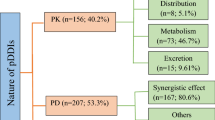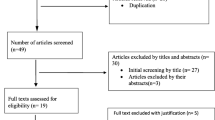Abstract
Background Multiple drugs therapies may be the potential source of drug–drug interactions that can result in alteration of therapeutic response and/or increase untoward effects of many drugs. Objective To identify the frequency and levels of potential drug–drug interactions (pDDIs) in internal medicine wards and their association with patients’ age, gender, length of hospital stay and number of prescribed medications; and to describe management of frequently identified major or moderate pDDIs. Setting Internal medicine wards of two major tertiary care hospitals of Khyber Pakhtunkhwa, Pakistan. Method Micromedex Drug-Reax system was used to screen patient’s profiles for pDDIs. Logistic regression was applied to determine the odds ratio for specific risk factors of pDDIs i.e., age, gender, hospital-stay and number of medications. Main outcome measure Overall prevalence and prevalence of contraindicated, major, moderate and minor pDDIs; levels of pDDIs; frequently identified major or moderate interactions; and odds ratios for risk factors. Results Total, 188 interacting drug-combinations were identified that contributed to 675 pDDIs. Of 400 patients, 52.8 % patients were presented with at least one pDDI (overall prevalence), 21.3 % with at least one major-pDDI, and 44.3 % with at least one moderate-pDDI. Of 675 pDDIs, most were of moderate (63.6 %) or major severity (23 %); good (61.2 %) or fair (25.5 %) type of scientific evidence; and delayed onset (50.2 %). Most frequently identified major or moderate interactions resulted in 45.3 % of all pDDIs. Their potential adverse outcomes included hepatotoxicity, bleeding, ototoxicity, nephrotoxicity, hypoglycemia, hyperglycemia, risk of thrombosis, hypotension, cardiac arrhythmias and reduction in therapeutic-effectiveness. There was significant association of the occurrence of pDDIs with patients’ age of 60 years or more (OR = 2.1; 95 % CI = 1.3–3.3; p = 0.003), hospital stay of 6 days or longer (OR = 2.6; 95 % CI = 1.5–4.5; p = 0.001), and seven or more number of prescribed medications (OR = 5.9; 95 % CI = 3.6–9.6; p < 0.001). Conclusion The present study has recorded a high prevalence of pDDIs in internal medicine wards. Patients with old age, longer hospital stay and increased number of prescribed medications were at higher risk.
Similar content being viewed by others
References
Juurlink DN, Mamdani M, Kopp A, Laupacis A, Redelmeier DA. Drug–drug interactions among elderly patients hospitalized for drug toxicity. JAMA. 2003;289:1652–8.
Becker ML, Kallewaard M, Caspers PW, Visser LE, Leufkens HG, Stricker BH. Hospitalisations and emergency department visits due to drug–drug interactions: a literature review. Pharmacoepidemiol Drug Saf. 2007;16:641–51.
Chatsisvili A, Sapounidis I, Pavlidou G, Zoumpouridou E, Karakousis VA, Spanakis M, et al. Potential drug–drug interactions in prescriptions dispensed in community pharmacies in Greece. Pharm World Sci. 2010;32:187–93.
Zwart-van-Rijkom JEF, Uijtendaal EV, Ten Berg MJ, Van Solinge WW, Egberts ACG. Frequency and nature of drug–drug interactions in a Dutch university hospital. Br J Clin Pharmacol. 2009;68:187–93.
van den Bemt PM, Egberts AC, Lenderink AW, Verzijl JM, Simons KA, van der Pol WS, et al. Risk factors for the development of adverse drug events in hospitalized patients. Pharm World Sci. 2000;22:62–6.
Pirmohamed M, James S, Meakin S, Green C, Scott AK, Walley TJ, et al. Adverse drug reactions as cause of admission to hospital: prospective analysis of 18 820 patients. BMJ. 2004;329:15–9.
Krahenbuhl-Melcher A, Schlienger R, Lampert M, Haschke M, Drewe J, Krahenbuhl S. Drug-related problems in hospitals: a review of the recent literature. Drug Saf. 2007;30:379–407.
Vonbach P, Dubied A, Krähenbühl S, Beer JH. Prevalence of drug–drug interactions at hospital entry and during hospital stay of patients in internal medicine. Eur J Intern Med. 2008;19:413–20.
Anonymous. Report of the Health System Review Mission—Pakistan. Islamabad: World Health Organization, 2007.
Creese A, Gasman N, Mariko M. The world medicines situation: World Health Organization, 2004.
Ismail M, Iqbal Z, Hammad M, Ahsan S, Sheikh AL, Asim SM, et al. Drug utilization evaluation of piperacillin/tazobactam in a tertiary care teaching hospital. Healthmed. 2010;4:1044–55.
Khan FA, Hoda MQ. Drug related critical incidents. Anaesthesia. 2005;60:48–52.
Nishtar S. Pharmaceuticals–strategic considerations in health reforms in Pakistan. J Pak Med Assoc. 2006;56:S100–11.
Babar ZU, Jamshed S. Social pharmacy strengthening clinical pharmacy: why pharmaceutical policy research is needed in Pakistan? Pharm World Sci. 2008;30:617–9.
Ismail M, Iqbal Z, Khattak MB, Javaid A, Khan MI, Khan TM, et al. Potential drug–drug interactions in psychiatric ward of a tertiary care hospital: prevalence, levels and association with risk factors. Trop J Pharm Res. 2012;11:289–96.
Micromedex Drug-Reax® System. [database on CD-ROM].Volume 150. Greenwood Village, Colo: Thomson Reuters (Healthcare) Inc. 2011.
Tatro D, editor. Drug interaction facts: facts and comparisons. St. Louis: Wolters Kluwer Health; 2009.
Ibanez A, Alcala M, Garcia J, Puche E. Drug-drug interactions in patients from an internal medicine service. Farm Hosp. 2008;32:293–7.
Egger SS, Drewe J, Schlienger RG. Potential drug–drug interactions in the medication of medical patients at hospital discharge. Eur J Clin Pharmacol. 2003;58:773–8.
Riechelmann RP, Tannock IF, Wang L, Saad ED, Taback NA, Krzyzanowska MK. Potential drug interactions and duplicate prescriptions among cancer patients. J Natl Cancer Inst. 2007;99:592–600.
Riechelmann RP, Moreira F, Smaletz O, Saad ED. Potential for drug interactions in hospitalized cancer patients. Cancer Chemother Pharmacol. 2005;56:286–90.
Doubova SV, Reyes-Morales H, Torres-Arreola LdP, Suarez-Orteg M. Potential drug–drug and drug-disease interactions in prescriptions for ambulatory patients over 50 years of age in family medicine clinics in Mexico City. BMC Health Serv Res. 2007;7:147.
Baxter K, editor. Stockley’s drug interactions. 9th ed. London: Pharmaceutical Press; 2010.
Hansten PD, Horn JR, editors. Drug interactions analysis and management: St. Louis: Wolters Kluwer Health Inc.; 2008.
Acknowledgments
We are very grateful to administration, consultants and all other staff of Ayub Teaching Hospital, Abbottabad and Khyber Teaching Hospital, Peshawar, for administrative support; and Dr. Jibran Hasan Khan and Mr. Abdul Majid, for help in data collection. We wish to thank Mr. Sadeeq-Ur-Rahman, PhD student, Molecular Microbiology Department, Free University Amsterdam, the Netherlands, for reviewing the English grammar of the manuscript. .
Funding
The authors are very thankful to University of Peshawar for financial support.
Conflicts of interest
None to declare.
Author information
Authors and Affiliations
Corresponding author
Rights and permissions
About this article
Cite this article
Ismail, M., Iqbal, Z., Khattak, M.B. et al. Potential drug–drug interactions in internal medicine wards in hospital setting in Pakistan. Int J Clin Pharm 35, 455–462 (2013). https://doi.org/10.1007/s11096-013-9764-1
Received:
Accepted:
Published:
Issue Date:
DOI: https://doi.org/10.1007/s11096-013-9764-1




